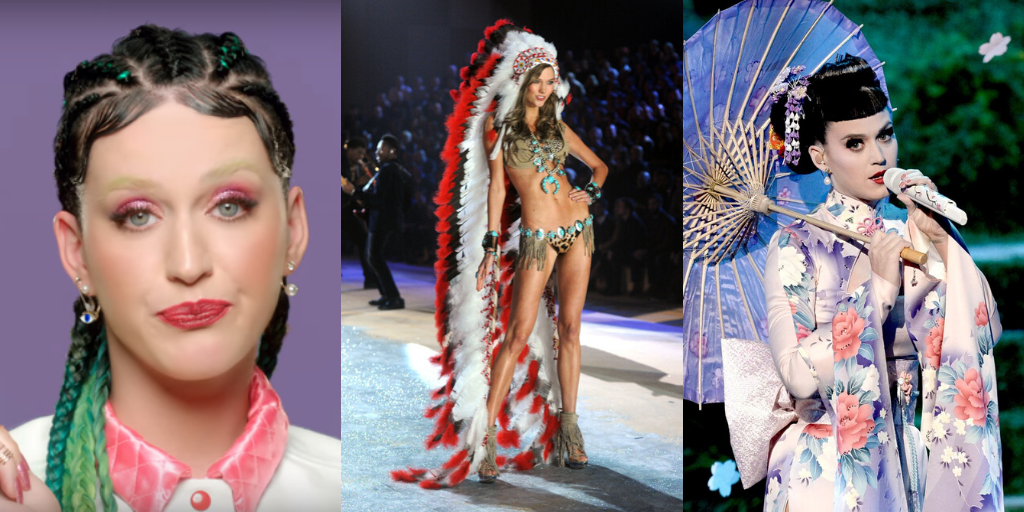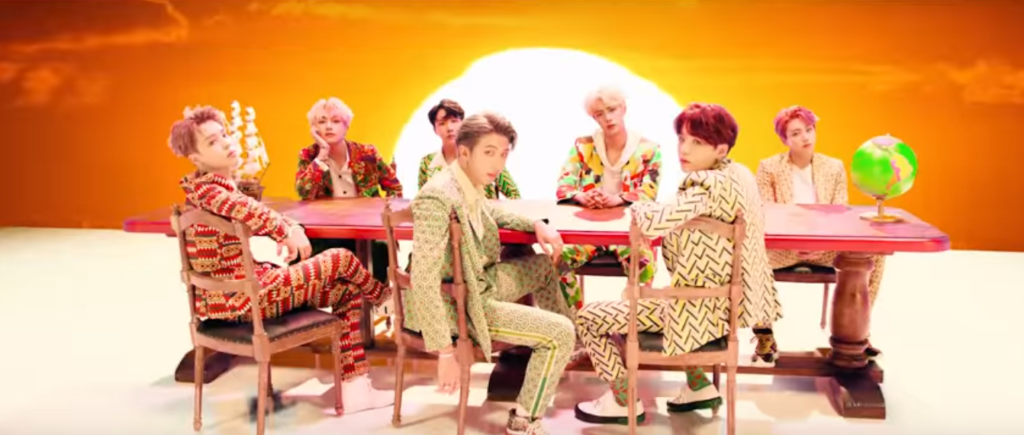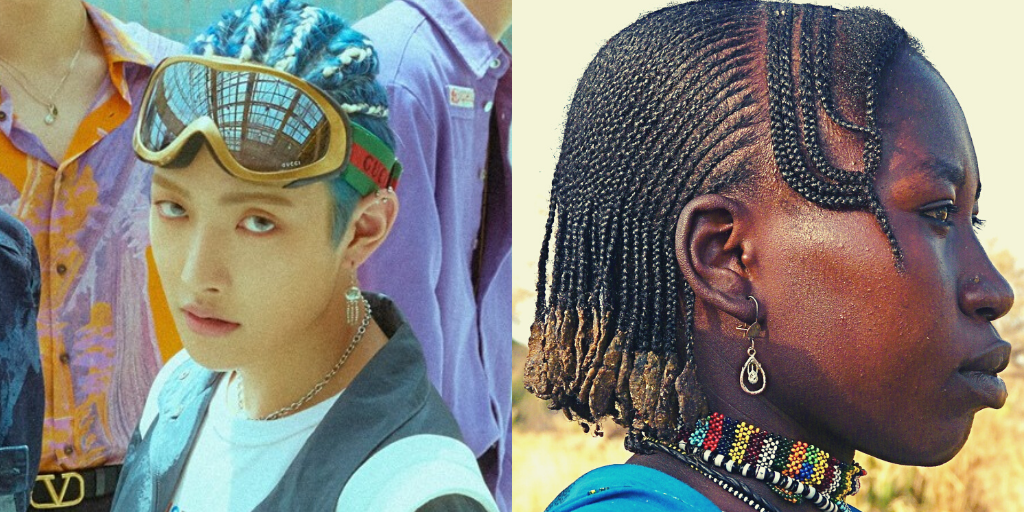(L-R) Hongjoong wearing blue cornrows in ATEEZ’s promo image for their upcoming album, ZERO: FEVER Part. 1. A Nuba woman in Nyaro village, Kau, Nuba Mountains, Sudan (KQ Entertainment, Rita Willaert/Wikipedia Creative Commons with added Canva filter)
K-pop group ATEEZ recently came under fire for a hairstyle the group leader, Hongjoong, was rocking in a promo picture. While the rest of the group had their hair in a variety of straight hairstyles, Hongjoong wore sky blue cornrows.

Fans came after the group for a problem that continues to plague the K-pop industry: cultural appropriation. The group’s management company, KQ Entertainment, released a Korean and English statement apologizing for the hairstyle.
Hello. This is KQ Entertainment.
We would like to genuinely thank our fans for your attention, love, and support to ATEEZ’s new album, <ZERO: FEVER Part.1> .
We would like to make an announcement in terms of the <Title #1, #2 Instrumental Teaser> of ATEEZ’s ZERO: FEVER Part. 1 released on 2020.07.14 00 AM.
From the images released on the 14th of July, ATEEZ member Hongjoong’s hair in Title #2 image was styled in consideration of the concept of the song, without any other particular purposes. Therefore, ATEEZ and we, KQ Entertainment, did not have any intention of commercializing or depreciating other culture[s] at all.
Through the issues and the opinions from our fans, we have become fully aware of the concerns and seriousness of this issue. From now on, we, KQ Entertainment, will try our best to fully review and check the historical backgrounds, characteristics, and cultures in the production process. We will not create issues that were not intended nor have expected.
Therefore, based on the opinions of our fans, we will change the hairstyle during the promotion and broadcasting activities that will take place after the release of this upcoming album.
However, we ask for your understanding that it is not possible to edit and modify the hairstyle of the member in this album’s photos, music videos, and other contents as we have completed the preparation for this album.
KQ Entertainment would like to take this as an opportunity to pay more attention to the racial, historical, and cultural issues and include balanced perspective[s] and viewpoint[s] in the contents that we release.
Thank you.
For me, the most crucial part of the apology is the last sentence: “KQ Entertainment would like to take this as an opportunity to pay more attention to the racial, historical, and cultural issues and include balanced perspective[s] and viewpoint[s] in the contents that we release.” I think that’s a very mature statement to make. With that focus on learning, I’m writing about why I believe Black Americans get so upset when non-Black stars–including K-pop stars–wear traditionally Black hairstyles and don other Black affectations.
Cornrow culture

For me, Hongjoong’s cornrows by themselves aren’t what’s offensive. If you’re puzzled by that, let me explain.
Every culture has braided styles. Braids keep hair safe and protected and tell others about their social class, affluence, etc.
Korean culture, for instance, has braided hairstyles as well, as shown in this article from The Talking Cupboard. The site references the Ko meori, a braided hairstyle for married women of lower classes of the Joseon Dynasty, and Eonjun meori, a more exaggerated and expensive form of the traditional married woman braided hairstyle. There are many braided styles listed in the article for both men and women, detailing marital status, wealth, and other social signifiers.
KoreaJoongAng Daily also writes about Joseon hairstyles, hats, and other accessories, writing that one of the common styles for court ladies was saeang hair, which included a braid interlaced with a daenggi, or a red ribbon.
So, if every culture has braided styles integral to that culture’s inner workings, why is it such a big deal that Hongjoong wore cornrows? My theory is that it’s because too often, cornrows and other African styles are divorced from their culture of origin. If someone outside of Korean culture wore their hair in the saeang style, for instance, they’d immediately have to reckon with the thousands of years of civilization that go along with that style. It would be hard to use the excuse, “This is just a hairstyle I like, so I’m going to use it because it’s cool.” Similarly, if we use American examples, it’s hard to excuse wearing Native American headdresses solely for fashion since they have unique social and cultural meaning. To introduce them as “fashion” devoids it of that meaning.
The anger over Black hairstyles comes into play because African-American culture, the playground in which K-pop resides, is often treated as mere aesthetic instead of as a living, breathing culture. It’s a culture that descendants of African slaves in America cobbled together from nearly-forgotten traditions and new influences, creating a brand new way of life. It has an extensive history that America, and other parts of the world, routinely forget. I think it’s easy for people to misuse African-American culture because others view African-Americans as disposable, nation-less people. If we belong to no one, then we can be mined for our riches without anyone caring.
Cornrows aren’t just a fresh style; they have a deep history that’s as long as the reign of humanity itself. According to Doria Adoukè, cornrows are one of humanity’s oldest hairstyles, with the ancient figures, the Venus of Brassempouy and the Venus of Willendorf, wearing what we now call cornrows (named as such because the hair resembles sown fields of corn). The figures are dated at around 22,000 B.C. Europe and were similar to styles worn in Africa, proving that the hairstyles migrated from Africa.
Adoukè writes that cornrow hairstyles “would spread throughout the rest of Black Africa” and “[b]raided hair showed the wearer’s caste, different life events (wedding or bereavement) or social rank.”
Ancient Egyptians, she wrote, used the hairstyle to mark social status, and were “often ornamented with gold thread and other refinements” as well as scented with oils and lotus flowers. People of different economic levels and professions also wore braided styles.
STEM education site CSDT‘s presentation on the “History of Cornrow Braiding” shows a statue from Nigeria’s Nok civilization. The statue, which dates back to 500 B.C., features a sitting figure wearing a cornrow style. “Cornrow hairstyles in Africa…cover a wide range of social terrain: religion, kinship, status, age, ethnicity, and other attributes of identity can all be expressed in hairstyle,” the site continues. “Just as important is the act of braiding, which transmits cultural values between generations, expresses bonds between friends, and establishes the role of professional practitioner.”
Cornrows migrated from Africa to the Americas during the Transatlantic Slave Trade and remained one of the remnants African-Americans have of their African roots.
Since there are tons of history behind the cornrow style, CSDT writes about how slavers shaved off African slaves’ braids during capture. On the surface, it was supposed to be for sanitary reasons, since the voyage from Africa to the New World would be dirty, disgusting, and arduous. But, the site writes, the act also had “the psychological impact of being stripped of one’s culture.”
“Re-establishing traditional hair styles in the new world was thus an act of resistance; one that could be carried out covertly.”
I think when Black Americans see others wear our traditional hairstyles, it’s communally triggering to us on a conscious and subconscious level. It’s because so much of our culture, including our names, has been taken from us, and we want to preserve the few untouched practices we have left. When we see others wear our hairstyles just for fashion and without regard for historical context, it’s as if we’re mentally stripped of our culture all over again. Seeing others not pay respectful homage to our culture is harmful to the African-American spirit.
Similar versions of this argument can apply to other minority groups, such as the Native Americans. They were nearly wiped out by white American settlers and the American government, only to have their culture stripped away or repurposed into offensive mascots. Japanese-Americans can feel some of this angst as well, with ancestors living through American internment only to have parts of their culture, such as the Geisha, stripped of meaning and turned into a Halloween costume (ditto again for Native Americans).

Can you wear cornrows?
To me, the answer to this question is both simple and complex. The short answer: yes, you can wear cornrows. You can wear whatever hairstyle you like. The problem is if you are wearing it in appreciation of a culture, or are you wearing it trying to appropriate?
According to the Cambridge Dictionary, cultural appropriation means “the act of taking or using things from a culture that is not your own, especially without showing that you understand or respect this culture.” Wikipedia goes a step further in its definition, writing that it’s “the adoption of an element or elements of one culture by members of another culture. This can be controversial when members of a dominant culture appropriate from disadvantaged minority cultures.”
“According to critics of the practice, cultural appropriation differs from acculturation, assimilation or equal cultural exchange in that this appropriation is a form of colonialism,” Wikipedia continues. “When cultural elements are copied from a minority culture by members of a dominant culture, these elements are used outside of their original cultural context–sometimes even against the expressly stated wishes of members of the originating culture.”
On the other hand, the Urban Dictionary defines cultural appreciation as “taking the time out to learn about different cultures and their traditions. To become more open in understanding the truths about a culture and embracing them in a respectful manner.”
Greenheart.org has an article defining cultural appreciation, explaining appreciation as “when one seeks to understand and learn about another culture in an effort to broaden their perspective and connect with others cross-culturally.” Meanwhile, they define appropriation as “simply taking one aspect of a culture that is not your own and using it for your own personal interest.”
Taking elements of popular Black culture, such as streetwear, hairstyles, and even the musical style of R&B itself, are examples of how K-pop takes Black culture for personal interests. I’m not the first to realize that the K-pop industry uses Black culture as an aesthetic and money-making opportunity without considering the history behind the cool fashion and swag. I’m also not the first to call the industry out on what it does; legions of fans have called out K-pop, but other fans usually silence them.
If K-pop wants to participate in Black American culture, then there has to be a cultural exchange. The industry has to show that they want to learn more about the history behind the aesthetic they love. They have to put in the time and effort to be uncomfortable, shift their mindset, and think differently about their global fanbase.

They’re going to have to give back to their Black fans since it is those fans’ culture they are using. Part of the exchange includes taking stock of the types of hairstyles they use. At least, if a K-pop idol does wear cornrows in the future, fans can be sure that it would be coming from a place of appreciation since that idol would have shown a more profound knowledge and respect for Black culture.
And to be clear, when I say “Black culture,” I don’t mean the gang-banging stuff that has become part of America’s pop culture exports. I mean actual African-American culture (one reference the industry could use is my book, The Book of Awesome Black Americans). K-pop should show a willingness to continue to learn about the complexities of African-American life if they are going to continue to use Black culture as an inspirational springboard.
Taking stock

I think we all can find empathy for Hongjoong because we all have done some appropriation in the past without meaning harm. I don’t believe Hongjoong intended harm by wearing colorful cornrows. But we, including Hongjoong and his group, can use this opportunity to think more about how we interact with others, especially when it comes to being intercultural. In any exchange, you want to give more than you take, and for many fans, K-pop does a lot of taking without giving. If K-pop intends to even the score, they have to show genuine interest in Black culture, the same level of interest Black fans give them. It’s only fair.
Then we can talk about cornrows.
